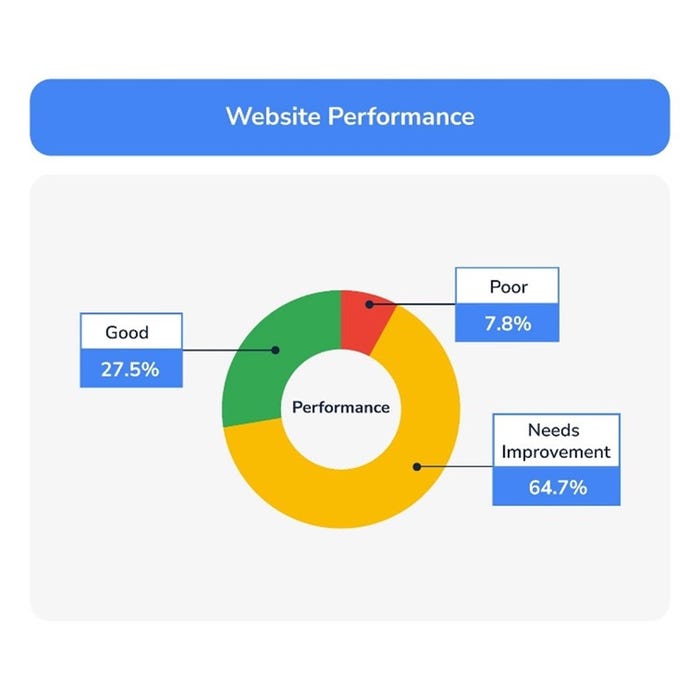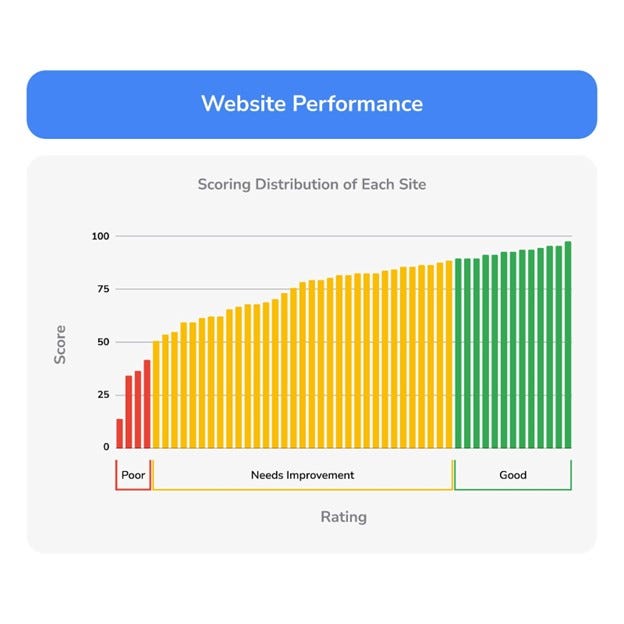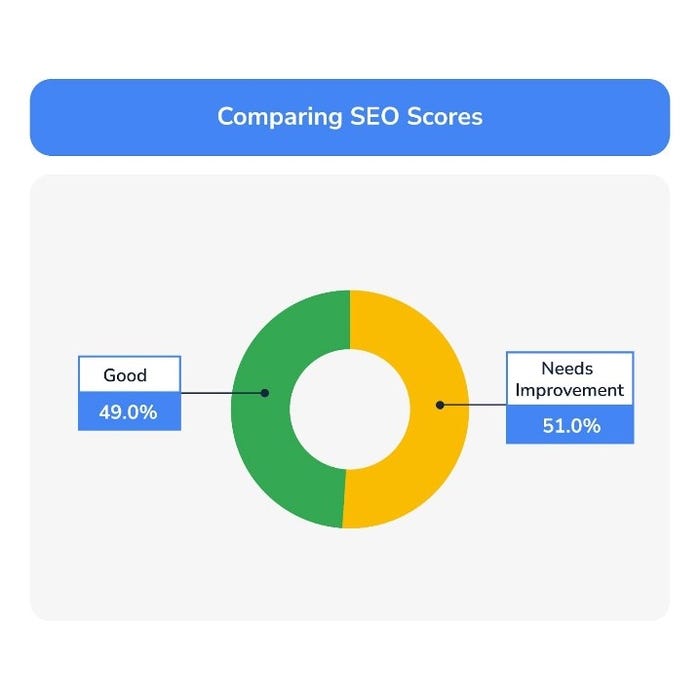Not meeting accessibility requirements, having secure domains, or taking advantage of progressive web apps are some ways your website is hurting the business.
March 23, 2023

Many business-to-business (B2B) websites for medical equipment and diagnostic companies compromise their growth potential because their websites don’t meet Google’s pagespeed insights criteria. At stake for low-performing websites are weaker organic search performance and poor user experience.
An analysis of 50-plus medical websites revealed that Colab Health scored 99 for performance, one point shy of a perfect score. Three other sites scored in the 90s on four Google tests that evaluate performance, accessibility, best practices, and search engine optimization (SEO). Four sites scored below 49, putting them in the “poor” category. One site scored a 14. Companies that optimize their websites position themselves to outperform competitors.

Beyond Website Design
The results of the study indicate that most medical-related B2B companies will need help to capture a more significant share of increasingly shrinking markets. A website may look stunning, but the technical underpinnings must be corrected. As the pool of new customers shrinks due to increased competition, an uncertain economic future, and market consolidation, businesses can’t afford to have their websites be the obstacle to growth.
Poor-performing websites negatively impact key performance indicators (KPIs) for marketing and sales, including:
Fewer sales leads and lower revenue due to fewer prospects coming to the website organically from search engines.
Higher bounce rates when new visitors immediately leave the site due to a poor browsing experience.
Falling search rankings as Google elevates your competitors and pushes you down the page below websites it believes are higher quality.
Loss of traffic when fewer people see you in search as a result of falling rankings.
Lost opportunities for international engagement and new business when your site runs slowly on low-bandwidth networks.
Poor user experience reflects poorly on your brand and the quality of your business offerings.
Performance: Why it matters
Almost every online and offline marketing tactic relies on a website. Users arriving at a website from social media, email, advertising, media mentions, or a link from a business card leave quickly if they have to wait for more than one or two seconds.

A high-performance website does more than improve search positioning. It elevates the brand for all audiences, no matter where they originate or how they discover the website. It differentiates your brand and provides valuable support and resources to new and existing customers, all packaged in an engaging and high-quality user experience.
With a better user experience (UX), websites earn higher conversion rates for higher-quality leads from prospective customers. For existing customers, the website elevates your brand and customer experiences by enhancing the quality of their service or support. The performance score incorporates six assessments with technically-obtuse titles within what Google calls “core web vitals”.
Core web vitals performance metrics:
First content paint
Speed index
Largest contentful paint
Total blocking time
Cumulative layout shift
In a nutshell, these terms reflect how quickly content loads and the speed of the website. Higher scores for performance indicate a site that offers an improved user experience.
Best Practices: Why websites struggle to perform
Companies rely on best practices because these tested methods offer consistency and confidence, especially with regulators, customers, and consumers scrutinizing everything. Similarly, website developers rely on best practices for reliability and performance.

Many of the medical-related websites reviewed get it right. About 60% of the medical websites tested meet development best practices, scoring 90-plus. Of those sites needing improvement, two don’t use secure domains (HTTPS), a shortcoming every visitor quickly experiences. One website without secure hosting offers packaging services, and the other site produces implant devices.
Out of real or perceived risk, users often make for a quick exit after navigating to a not secure website. That hurts business.
Best practices for websites:
Avoid requesting the geolocation permission on page load
Avoid requesting the notification permission on page load
Allow users to paste into input fields
Serve images with appropriate resolution
Page has the HTML doctype
Properly define charset
Avoid unload event listeners
Avoid deprecated APIs
No browser errors logged to the console
No issues in the Issues panel in Chrome Devtools
Display images with an incorrect aspect ratio
Strong Content Security Policy (CSP)
Detected JavaScript libraries
Source maps deployed
Uses HTTPS
About the website study
A study of 50-plus websites representing various sectors was conducted in March. The segments sampled included life-saving medical devices, implantable components, packaging services, contract services, etc.
The analysis examined websites for medical devices, diagnostic equipment, and services companies. Some companies selected were featured in recent MD+DI news. Other companies were selected from Google searches for medical-related segments and included companies featured in sponsored links in search results and high- and mid-ranking organic results.
About the scoring
The scores for the four tests break down into three divisions. Websites with scores between 90-100 are considered good. The second category for scores 50-89 indicates needs improvement. Sites that register scores below 50 are considered poor.
Snapshot of results:
One website scored 99 out of 100 for performance. Fourteen scored above 90.
Four websites scored poorly on the performance test.
Nearly 60% of the websites scored above 90 for best practices.
66% of the websites risk legal liability for not meeting web accessibility criteria.
Half the websites scored above 90 on the SEO test, putting them in the “Good” category.
None of the websites are a Progressive Web App (PWA).
The results of the study match a larger analysis of 200-plus industrial websites in February.
Quick takeaways:
Underperformance is industry-wide: While some of the sites reviewed were visually appealing, the findings paint a larger picture of company websites across various sectors all needing moderate or significant improvements in coding and architecture.
Poor accessibility creates legal exposure: The majority of websites do not meet basic accessibility standards established by WCAG and mandated by legislation in various countries throughout the world, including the ADA.
Progressive web apps (PWAs) are rare: Even as Google tests websites for PWA requirements and considers them a best practice for search performance, only one website in the study is built as a PWA.
Why manufacturer websites fail to achieve high-performance
Mid-market companies typically do not have the in-house expertise to design, develop, and maintain a healthy website that performs up to the highest standards, or they may settle for "good enough" because they’re unaware of the lost opportunity.
Kao Collins, a global industrial inkjet ink manufacturer, bucks that trend. Medical and pharmaceutical packaging companies use the company’s inks. The Cincinnati-based B2B company achieves the highest scores on the test. Recent testing showed that the company’s website registered perfect scores for every Google category.
“We focus on maintaining our website’s high performance because we know how essential it is to our growth," said Kristin Adams, the company’s marketing manager. "It represents our brand on the world stage and ensures our potential customers have a positive impression of our company the first moment they visit kaocollins.com."
Optimizing the site’s technical performance also supports the company’s effort to attract and engage new audiences in locations worldwide where site visitors may have poor network connections.
Accessibility isn’t a luxury
Over half of the sites reviewed scored below the threshold for a website to be generally considered accessible. Of the 31 sites scoring below 90 points, 12 sites scored below 80.

Two low-performing sites stood out because their products and services center on accessibility. One company, a Scandinavian prosthetics equipment company, scored 63 on the accessibility test. The other company, a medical equipment design firm, scored 70.
Despite notable lawsuits against companies like Domino's Pizza, Target, and Harvard University, companies have not gotten the memo about the need for building and maintaining a website that complies with the Americans with Disabilities Act (ADA) or the EU Web Accessibility Directive. Today that generally means the WCAG 2.1 AA criteria.
Benefits of an accessible website:
Improved search engine performance
Positive brand reputation
Faster user experience
Improved user pathways
Attracts and serves a broader audience
Reduces legal exposure
The accessibility scores for medical-related websites match the findings of a similar study of 200-plus industrial websites. About 60% of these websites have scores below 90.
Websites that meet Web Content Accessibility Guidelines administered by the World Wide Web Consortium (W3) offer a superior user experience for everyone, regardless of ability. For example, an older B2B buyer may have vision difficulties, while a younger buyer may have a temporary impairment from an extreme sports injury that makes using a mouse difficult. A website designed and developed to meet accessibility requirements typically achieves higher search rankings. Incorporating the nuances that make a website accessible pays dividends for SEO and user experience.
The mobile experience matters
The analysis of websites in the medical equipment and diagnostic sector matched the findings of the industrial websites. None developed websites developed to Progressive Web App (PWA) criteria. Simply put, PWAs are a way of building websites that are faster, more responsive, and capable of performing like an app, yet can still be indexed for search and usable as a traditional website. The architecture of a PWA supports a better user experience.
PWA benefits:
Speed: Fast loading time
Operates on poor networks
Small development footprint
Integrates app-like features
No app stores, no downloads
Instant updates
A company’s lack of a PWA significantly affects the increasing number of international B2B companies buying or selling products or services. Without a PWA, new and prospective customers can’t reliably use a business site that struggles to load on low-performance networks.
A Forrester report estimates that Millennials comprise about 73% of B2B buyers in the customer journey. This group and the upcoming Gen Z use mobile devices and expect high performance. Medical equipment companies looking to attract international business should consider implementing a PWA.
SEO success requires more than keywords
B2B and business-to-company (B2C) marketing teams understand the importance of content marketing focused on keywords. The study results indicate that half the companies miss the SEO mark. On the upside, four of the “good” 50 websites scored 100 for SEO. Success in this performance category involves more than incorporating keywords throughout copy. Digital marketers can perform some of the optimization tactics without technical skills. Other requirements often require website managers and developers, or ongoing help from outside experts.

SEO Criteria:
element
Has a tag with width or initial-scale
Document has a
Document has a meta description
Page has successful HTTP status code
Links are crawlable
Page isn’t blocked from indexing
Image elements have [alt] attributes
Document has a valid hreflang
Document has a valid rel=canonical
Document avoids plugins
Descriptive link text
Partnering to help your website stay healthy
The “poor” scores highlighted in the survey represent a great opportunity for businesses to implement website performance improvements. Companies can document the results of the effort with improved search rankings and higher click-through rates. That may be a challenge for companies already stretched thin as they face challenges with the supply chain, employee hiring, and retention, and more.
While a company often tracks website performance with Google Lighthouse, Page Speed Insights, Google Trends, etc, most B2Bs need experts in the latest SEO trends and all of Google’s tools to improve search rankings, visibility, and user experiences.
Kim D. Kolarik is a digital strategist at DBS Interactive, a Louisville-based digital agency with offices in Cincinnati, Orlando, and Nashville, that produces high-performance websites, apps, and integrated marketing.
About the Author(s)
You May Also Like


